January 2, 2015
Air Date: January 2, 2015
FULL SHOW
SEGMENTS
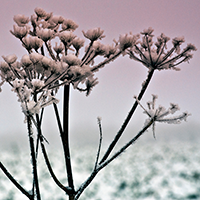
The Return of Bride
/ Mara FreemanView the page for this story
Pagan lore has it that in the wintertime a bitter old goddess keeps the young goddess of spring imprisoned in her mountain castle. Only when the young goddess has been freed by her true love can springtime return to the land. Mara Freeman is a druid from the British Isles and a Celtic storyteller and harpist. She shares a tale of light and love called “The Return of Bride.” (12:30)
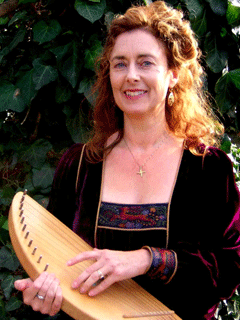
Light of the Isles
/ Mara FreemanView the page for this story
We return to Mara Freeman to learn about Angus the Ever Young who was worshiped by ancient druids and pagans as the king of light and youth. (03:30)
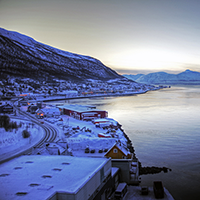
A Chilling Norwegian Draugen Tale
/ Heidi DahlsveenView the page for this story
You never know what might be lurking in the freezing fjords of Northern Norway on a winter’s eve. Storyteller Heidi Dahlsveen shares Norwegian folktales to lighten even the darkest winter night. (13:45)
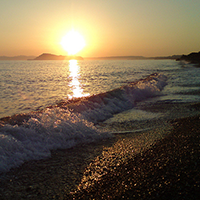
The Sun, An Ogre?
/ Manya MaratouView the page for this story
The sun is a source of light and brings new life, but for farmers working in the fields, the sun can be oppressive. In Greek stories, the sun is often characterized as an ogre. But as Greek storyteller and musician Manya Maratou tells host Steve Curwood, the sun also has a soft side. (18:00)
Show Credits and Funders
Show Transcript
HOST: Steve Curwood
GUEST: Mara Freeman, Heidi Dahlsveen, Manya Maratou
[THEME]
CURWOOD: From Public Radio International - this is Living on Earth.
[THEME]
CURWOOD: I’m Steve Curwood. Tired of bad news? Get ready then for a break from the usual, and sit back for s our holiday storytelling special, but you may still be in for a scare!
DAHLSVEEN: And he had just stepped out of the boat when he heard a sound. SLUUURRRP. And he slowly looked up, and when he saw what he saw, he was petrified.
CURWOOD: But as they say, all’s well that ends well, and what’s a happier story than the solstice and return of the sun?
FREEMAN: The first rays of that morning sun on that special day of the year would come shooting down that narrow passage and light up where the people would have been waiting for this tremendous rebirth of the light at this time of the year.
CURWOOD: Stories to celebrate the season of light this week on Living on Earth, Stick around.
[THEME]
ANNOUNCER: Support for Living on Earth comes from United Technologies – innovating to make the world a better, more sustainable place to live.
The Return of Bride
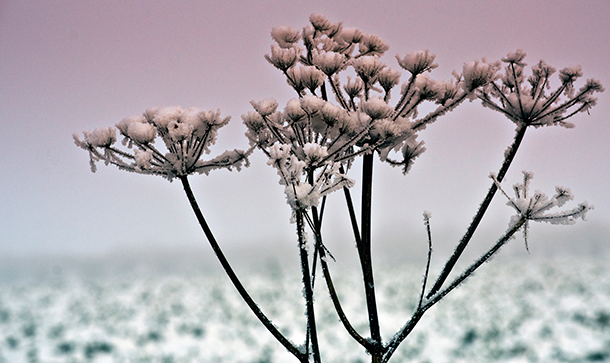
Winter holds strong, refusing to give way until Bride finds her love. Only then will spring return to the land. (Photo: Jon Bunting; Flickr CC BY 2.0)
CURWOOD: From the Jennifer and Ted Stanley studios in Somerville, Massachusetts, this is Living on Earth. I’m Steve Curwood. The trouble with December, I seem to remember, is the sun gets so lazy and the short days make us crazy. But just as it seems the darkness will win, the time of more light finally begins, so we celebrate the New Year with our gifts and good cheer, but the best part of all, for the grown up and small, are the stories we tell, as we wish our friends well.
So today, once again, for this season of changing light we take a break from the news. Maybe you want to throw another log on the fire, or brew up a cup of tea or hot chocolate, but whatever you do, please join us while we swap some stories.
For this Living on Earth storytelling special we’ll head to the Fjords of northern Norway for a scary tale from the darkest night of the year. And we’ll spend some time on a sunny Grecian island where the sun can be as much an ogre as a bright blessing. But we’ll begin our travels in the British Isles, where for thousands of years, druids have been celebrating light around the time of the Northern winter solstice, that shortest of days.
But not to worry, ol’ Sol is coming back. And that is cause for great festivities in the pagan and druid faiths that date long before Christmas and Chanukah came onto the calendar. Mara Freeman is a druid, and also a Celtic storyteller, and she joins me now.
Ms. Freeman, welcome to Living on Earth.
FREEMAN: Thank you it’s great to be here.
CURWOOD: Now, what’s a Druid exactly?
FREEMAN: A druid is someone who follows an earth-based tradition that honors the earth as an ensouled animate being that is shot through with the divine. And this is something that we’ve lost over the last centuries, with industrialization, increasing technology that has kept us, perhaps, away from that close connection with the earth as a living being that our ancestors used to have.
CURWOOD: Now you brought with you to help tell the story, a zither. Um, what is a zither?
FREEMAN: Well, the zither it’s the name that’s given to many different kinds of flat wooden instruments, strung with multiple strings. This is a zither that’s actually tuned pentatonicly to the scale that’s used in most Celtic music. So, it has a very nice Celtic feel to it.
CURWOOD: Can I hear it for a moment?
FREEMAN: Sure.
[STRUMMING ZITHER]
CURWOOD: Oh, it sounds like I should be heading off to dreamland or something.
FREEMAN: (laughs)
CURWOOD: You have a story for us that comes from the Pagan tradition. I wonder if you could tell that for us.
FREEMAN: Right, shall I tell you a little bit about the story first, Steve?
CURWOOD: Sure.
FREEMAN: This story is actually from Scotland and um, I should probably tell you that for the ancient Celts there were really two parts of the year; the dark part, the winter part, and the summer part. And they were personified or regarded by the people in those times as two faces of a great goddess. And she had different names according to weather this was her winter aspect or her summer aspect. In the winter she was called the Cailleach, which is a word meaning the veiled one. And she was seen as this rather fearsome old woman of winter. And her bright side, which returned when spring came along was Bridget, who in Scotland is also known as bride. And Bride is the young maiden who ushers back the warm light-filled days of the early spring. So this story is actually called the Return of Bride.
[ZITHER MUSIC]
FREEMAN: The Cailleach Bheur was the old woman of winter in Scotland. She was very tall and very old, and everyone was afraid of her. Her face was blue and she only had one eye. Her teeth were red as rust, and her long hair as white as an aspen covered with snow. When she was angry she was as fierce as the biting north wind, and she roared like the sea in storm. Every autumn she struck the ground with her magic hammer and turned the grass into blades of ice.
All winter long, the Cailleach kept captive a beautiful young princess named Bride. She was jealous of her beauty, and gave her ragged clothes to wear and made her work in the kitchen of her castle in the mountains.
Now the reason the Cailleach Bheur kept Bride a prisoner was because her favorite son, whose name was Angus-the-Ever-Young, had fallen in love with her. Angus lived on the Green Isle of the West, which is also called the Land of Youth, and he never grew any older. The Cailleach knew that if he ever married Bride, he would be able to take his place as the Summer King and Bride would be his queen. Then the Cailleach’s reign would be over.
Angus gazed into the Well of Youth that lies at the heart of the Green Isle. He saw storms and he saw winds – and he saw Bride all alone weeping in her castle prison. Straight away, he went to the King of the Green Isle and said, “I must go to her at once and set her free!”
But the King of the Green Isle said, “You cannot go now, Angus, for February, the month of the wolf, has come, and uncertain is the temper of the wolf. Wait a while until the grass begins to grow and flowers start to bloom, and then you shall set Bride free.”
But Angus said, “I shall cast a spell on the sea and a spell on the land, and borrow for February three days from August.”
And so he borrowed three days from August, and the sun came out and shone like pale gold over mountain and glen, while the sea lay smooth as buttermilk. Angus mounted his white horse and rode eastward to Scotland over the isles and over the Minch by day and by night, and he reached the Grampian Mountains just as the dawn was breaking. As he rode his royal robe of crimson streamed from his shoulders and his cloak of shining gold spread out all around him, setting the mountains ablaze with light.
For three days Angus rode up and down the land, but he could not find Bride anywhere. Then one day, as he rode through a thick and tangled forest, he heard a soft sad voice singing among distant trees. It was Bride in the woods near the castle, where the Cailleach had sent her to gather logs for the fire. Angus gazed upon the living girl whom he had only seen before in a vision, and called her name.
Said Angus, “I have come to rescue you from the Cailleach who has held you prisoner all winter long.”
Bride replied, “For me this is a day of great joy.”
Said Angus, “From this time forth it will be a day of great joy to all of Scotland, as well.”
For the day on which Angus found Bride was the first visit of spring, which ever after was called, “Bride’s Day.” The hard earth began to thaw, and blades of new grass pierced the softening soil. Pale yellow primroses glowed in the woods, and young leaves unfurled on branches, green and tender.
Yet the Cailleach’s reign was not yet over. When she found out what had happened, she and her eight hag-servants mounted their shaggy black goats and rode out of the mountain to wage war upon Angus and Bride. First she raised the wind called The Whistler, which blew high and shrill, and brought down showers of cold hailstones. It lasted for three days, and killed the sheep and their new-born lambs upon the moors. Then she raised the Sharp-billed Wind that lasted for nine days and pierced the land to its core, pecking and biting like a sharp-billed bird. Finally, she raised the eddy wind that is called The Sweeper, whose whirling gusts tore branches from the budding trees and bright flowers from their stalks. Angus was moved with pity for the people, whose horses and cattle died for want of food. He drove the hags back to the far north, where they fretted and fumed in a fury.
But that night, the Cailleach Bheur borrowed three days from winter which had not been used, because Angus had borrowed three days from August. The three days of winter were spirits of the storm, and the Cailleach let them loose upon the land, riding on the backs of black hogs. They summoned the snow to the newly ploughed fields, and breathed the winds of death into cottage window and stable door. The rivers rose in flood, and many were drowned. The days on which this happened were ever after called the Three Hog Days.
Then one bright morning at the beginning of March, the Cailleach saw Angus riding boldly over the hills on his white horse, scattering her hag-servants before him. She felt the unmistakable tide of life rising through the veins of the land, and knew it was too strong for her. She flung down her magic hammer and turned into a large grey standing stone on the slopes of the mountain, where she was forced to stay until the next wintertime returned.
Angus and Bride were married and wherever they stepped dandelions sprang up beneath their feet, and people called them the ‘little notched ones of Bride.’ As they rode throughout the land, the linnet sang of Bride’s beauty, and so she was known ever after as the “Bird of Bride.” When they came to the seashore, the first bird that chirped with joy was the oystercatcher, and so he is known as the ‘Page of Bride.’
Spring had come at last.
[ZITHER MUSIC]
CURWOOD: Thank you so much. I have to say, I’m ready for spring now.
FREEMAN: (laughs)
CURWWOD: I love all the images from this, particularly when she goes riding out on goats.
FREEMAN: (Laughs) Goats were often seen as somewhat in league with the devil, you know with that pointed face and that strange staring yellow gaze, the horns and so forth. So I think they’ve always been considered animals to be avoided, ones that were perhaps associated with a spirit known as the Pooka. The Pooka was a mischievous fairy that could often take the shape of a goat. So, it’s kind of natural that the goats became the steeds of the Cailleach and her eight hag servants.
CURWOOD: Mara Freeman’s story is called “Return of Bride.” We’ll be back in just a moment to hear more from Ms. Freeman, and then we’ll head to the dark Fjords of Norway for a winters tale that will chill you to the bone. Keep listening to Living on Earth.
Related links:
- Mara Freeman’s page
- Mara Freeman’s book: Kindling the Celtic Spirit
[MUSIC: Mara Freeman “Seasonal Celtic Zither Harp Music” performed live in ‘KAZU-FM (Monterey, CA)’ studio (December – 2006)]
Light of the Isles

Celtic storyteller Mara Freeman (Photo: Courtesy of Mara Freeman)
CURWOOD: It’s Living on Earth, I’m Steve Curwood and I’m still with Mara Freeman, the storyteller who just told us the story of “Return of Bride.” And I’d like to ask you to tell us more about this story. In particular, tell us about Angus? Who is he and how does he factor into Celtic lore?
FREEMAN: Well, as I think you can tell from the story Angus very much personifies the sun. You know he rides up and down the land and his royal robe of crimson streams behind him bringing back the light to land, particularly coming back in splendid fashion at the winter solstice. And there is an actual place in Ireland that celebrates the birth of Angus. And this is played out in an extraordinary fashion in the landscape. And that place in fact, a number of listeners probably will have heard of this place, is called Newgrange. And what it is is a huge great egg-shaped burial mound or earth-shaped chamber in the middle of the green meadows of the Boyne River in Ireland. Not far, it’s about 40 miles Northwest of Dublin. And Newgrange was built, oh more than 5,000 years ago, it’s extraordinary. And the marvelous or one of the marvelous things about Newgrange is that there’s a great spiral stone at its entrance way. You go beyond that spiral stone and you have to pretty much bend double to crawl along this long passage way that leads you into the heart of the chamber itself. It’s as if you’ve been going down this birth canal that opens up into the womb of the mother earth. And the womb is filled with these beautiful petroglyphs, rock art full of spirals and shapes that look like suns bursting into life. So, probably, thousands of years ago the druids and maybe the ancestors of the druids themselves would have been sitting in that chamber in the dark, perhaps fasting, perhaps praying um holding their ceremonies, awaiting the return of the light because on the morning of the winter solstice the light did in fact return. The first rays of that morning sun on that special day of the year would come shooting down that narrow passage through the vagina of the earth herself and light up the womb inside where the people would have been waiting for this tremendous rebirth of the light at this time of the year.
CURWOOD: Mara Freeman, you love telling this story of the return of Bride, why?
FREEMAN: Oh, it just has all the characters. You know, it’s a beautiful story. It’s a fairy tale itself but it’s also a story of the land. But for me the most important, the most vital, and vibrant stories of the Celtic, and really of all indigenous peoples, have to do with the earth herself. And I love the pieces about the linnet and the oystercatcher and the all the little details about nature because this is a true myth. You know myth is a reflection of what really goes on in our world, told as a story that all ages can understand. And so it’s a true story made alive and made dramatic for all to enjoy.
CURWOOD: Mara Freeman thank you so much.
FREEMAN: Thank you, Steve.
Related links:
- Mara Freeman’s page
- Mara Freeman’s book: Kindling the Celtic Spirit
[MUSIC: Anon Egeland “Anna Is Gone” from ‘Anon’ (Northside – 1999)]
A Chilling Norwegian Draugen Tale
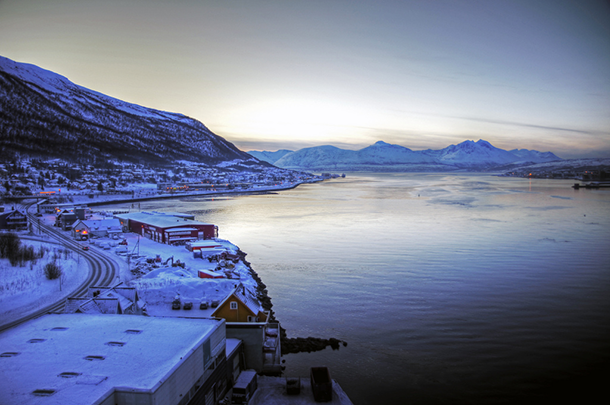
The coastal town of Tromsø in January. (Photo: Mariusz Kluzniak; Flickr CC BY-NC-ND 2.0)
CURWOOD: From the Green Isles of Angus the Ever Young, we head North and East now, to Norway. In Oslo at this time of year the sun rises around ten in the morning and sets at four in the afternoon, and there are parts further North that are in darkness 24 hours a day. Heidi Dahlsveen is a storyteller from a small island off the coast of Norway. She joins us now from Oslo, where she teaches storytelling at the Oslo College of Drama and Communications.
Heidi, Welcome to Living on Earth.
DAHLSVEEN: Thank you.
CURWOOD: Now, Heidi, your grandfather was a storyteller?
DAHLSVEEN: Yes, in one way you could say that, he loved to tell stories at least. But he mostly told stories from his own childhood and trying to keep the culture from his own time; teaching us about things on the island which we should avoid or where we should go etcetera and using stories to teach us.
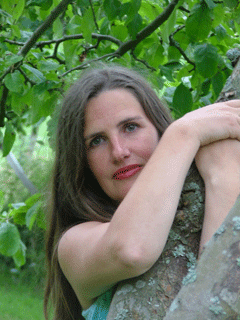
CURWOOD: What’s the one thing that you remember your grandfather teaching you, telling you the story?
DAHLSVEEN: He told us to avoid the well. I mean when you live on an island you have to be aware about the water. So he taught us about this, we have this strange well. I don’t know how to describe it. It’s not in a circle with stones around it but just huge wells, where the rain can come down. And he taught us about a creature called a Nekken who lived in there and who we should be really afraid of because he would take us down to his home, for instance.
CURWOOD: Ohhh (laughs)
DAHLSVEEN: Yes. So, that’s why we stayed alive, we stayed away from being drowned.
CURWOOD: Now Heidi you have a story that begins on a cold, dark, arctic night. You call it Draugon and the Keg. Now, how do I say it, not dragon, because the English word is dragon, but this word is...
DAHLSVEEN: Draugen
CURWOOD: And I’m sure we’ll learn what the draugen is. Please tell us your story.
DAHLSVEEN: I live in a part of Norway where it is not so dark. I mean it’s dark, but up North it’s even worse; it’s dark 24 hours. And this story happened in a place up north. And there lived a rich farmer, he owned a lot of land and a lot of animals and his farm was only ten minutes away from the fjord, the sea. So, he was also a fisherman with a few boats. And the boats were tied to the pier in the fjord. And he was what we would call in Norway, a fish farmer. And this farmer he needed a lot of helpers and workers to work on his farm. And he was a good man. He paid his helpers good and made sure they had everything they needed. The helpers and the workers they lived in a small house on the farm next to the main house in a house we call draingessteur.
And the story starts on a day when it’s time for a change; a day when the sun soon will return, a day we now call Christmas Eve. The working men were sitting in the little house. They just had been eating a good meal and was now sitting drinking liquor, burning liquor. And they enjoyed the time, talking telling but suddenly their glasses were empty. The bottles were empty and the night was still young. The farmer told them that they could go on drinking. There was more liquor stored in one of the boats tied in the fjord but it was a dark dark time. It was Christmas Eve. It was cold, dark outside and nobody felt like taking this ten minutes walk down to the fjord.
Among the working men there was a young man eager to prove that he was a man like the others. He jumped up and said, “I will do it. I will go down and I will get us all something to drink.” So he grabbed his warm coat, put on some heavy boots, a cap on his head, he picked up the keg and the other men cheered him as he left the warm house and stepped into the cold dark night.
And it was cold outside. The snow was covering the landscape and made the darkness lighter and the snow was hard so he could hear his own boots on the snow going like, CRUNCH CRUNCH CRUNCH. And the young man could see his own breath streaming out of him. And he walked until he reached a church and the churchyard, the church yard was surrounded by a fence built by stones put on top of each other. And it would have been much easier, much quicker for him to jump over the fence and run through the churchyard.
But it was the darkest night and he didn’t feel like doing it so he walked around and finally he reached the fjord. He could hear the sound of the small waves. He could feel the strong salty smell. He walked on the pier towards the boat. He jumped into the boat, filled the keg. He even took a sip himself. And the strong liquid warmed him, even out to his fingertips.
And he had just stepped out of the boat when he heard a sound. SLLLUUUURRRPP. And he slowly looked up and when he saw what he saw he was petrified. He looked straight at the fisherman’s and the sailor’s greatest fear; death itself. Draugen was standing in front of him and blocking his way. Draugen; once he was a brave fisherman or a sailor, too brave and head strong, with no respect for the ocean. He tried to steer his boat against the will of the ocean. He tried to conquer the ocean and was himself conquered by it. He drowned and came back as Draugen.
Draugen still carrying the dead man’s flesh, skin and clothes. Draugen. And because he had been so head strong and headless, he was now missing the head. Instead of the head it was sea tangle and seaweed on top of his shoulders. So, the young man was staring at this monster. And what could he do? He could not jump into the sea, it was too cold. And there was only one thing he could do. He gathered his strength, took a good grip around the keg, and walked slowly but steadily straight ahead.
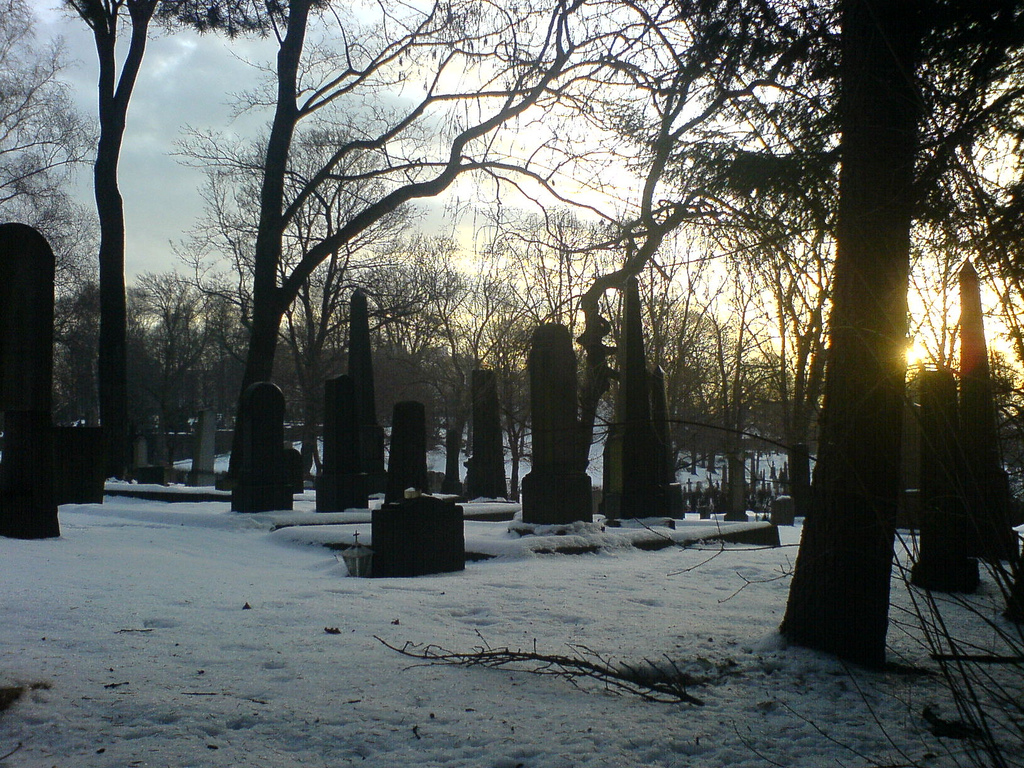
The fish farmer sprinted through a Norwegian churchyard trying to escape Draugen, and he called upon the souls of the dead to help save him from the grip of the evil spirit. (Photo: Geir Arne Brevik; Flickr CC BY-NC-SA 2.0)
And when he was so close to Draugen that he could feel the rotten smell he ran. And with all his force he pushed Draugen into the water and SPLASH Draugen was in the water and the young man he went on. He did not run but now he heard the sound behind him. He looked over his shoulder and he could see not one, not ten Draugen but the whole seashore was covered with the monsters and he ran. The young man he ran as fast as he could and he heard them coming closer and closer and soon he reached the churchyard. And he realized that he had to run through the churchyard otherwise they would over take him.
So he jumped over the fence and ran until he was in the middle of the churchyard. Draugen was also over the fence now, but in that moment he heard the bell going DONG DONG DONG twelve times, in the middle of the most dark night on Norway. And the young man, he got an idea. So on the top of his voice he called out, “Please all Christian souls help me.” And immediately he heard the cracking of coffins he heard how the earth was shoveled away. And the young man he started to run again. He jumped over the fence on the other side. He stopped turned and he saw how the dead people stood up from their graves. Some had been dead for a long time; only skeleton was left, others had just died and looked almost as if they were still alive. They grabbed pieces of their coffins, some broke crosses on their graves and they started to walk towards Draugen. And a fight started.
And the young man he turned. He went back to the farm. He went inside the small house; House Draingessteur. Pale, he was sweaty. And without a word he put the keg on the table, took off his clothes, climbed up to the attic and climbed on to his sleeping mattress. And he thought, “I wonder if I will survive this darkness.”
And the next morning he woke up and he thought, “I am not insane.” He put on his nice clothes, went downstairs. He looked out of the window and a small light as if hope was coming back he could see. And he told the other men about what had taken place the day before. They laughed and said he had been dreaming. It was a fantasy. And then they all went to church because it was a holy day. But when they reached the churchyard, all stopped. They stared. They could see how the churchyard was covered with pieces of crosses and coffins mixed with seaweeds and sea tangles.
And the young man wondered, “Hmmm, I wonder who won this fight in this dark night.” And that’s the end.
CURWOOD: So, if you live in a fishing community, a farm fishing community this is the story you here.
DAHLSVEEN: Yes, in that community, as I grew up in it, you are usually used to people losing someone on the sea. I mean the sea takes and the sea gives. I guess in that this creature has been created as a sort of comfort or warning.
CURWOOD: Do people still tell this story today because the fishing industry seems to be just about gone from Norway?
DAHLSVEEN: The storytellers tell that story. The Draugen, I think for children for instance, I think is disappearing as a creature in our minds. Yes, the fishing is disappearing and because the fish is disappearing and also because Norway is an oil nation, so it is the storytellers who keep this figure alive.
CURWOOD: You have another story for us about light at this time of year. I was wondering if you could tell that to us now.
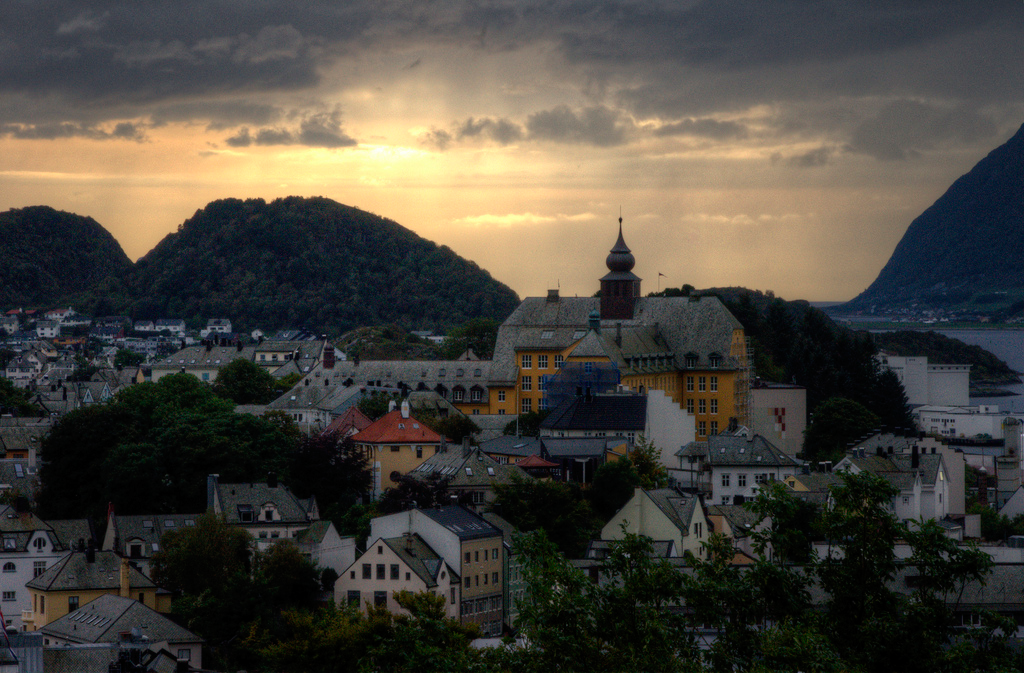
The Norwegian town of Alesund at sunset. (Photo: Mariusz Kluzniak; Flickr CC BY-NC-ND 2.0)
DAHLSVEEN: Yes, I will do it. It’s a much lighter story. It’s about this wanderer and as he was walking he came to a hill and he was standing on top of the hill he looked down into a valley. And in this valley he saw a small house. And out of the house he saw a woman running. And in her hands she had a bucket and a cloth. And she was running forth and back and suddenly she stopped and threw the cloth on top of the bucket and then she ran inside the house.
But after a short while he saw the woman running out of the house with a bucket in one hand and a cloth in the other. And again she stopped. She threw the cloth on top of the bucket and inside she ran. And this continued. And the man thought, “What is going on.” So he went down the valley towards the house and as the woman ran out he stopped her and asked, “Excuse me but what are you doing?”
And the woman she looked surprised at him and said, “It is the light. I mean in my old house the light always wanted to be inside my house. But then I built a new house and I cannot get the light inside. She does not want to be there. I’m trying to catch her. I get her inside of my bucket. I run inside the house I let her out and ZOOP she’s out again. She does not like my new house.”
The man looked at the house and now he realized that there were no windows there. They had forgotten to make windows in the house. “Ah,” the man said, “I know a way to get light back to your life.” So he made windows, one in each wall so light could come from every corner of the world. And the woman, she was so happy. She paid the man well and he went on, knowing that light is somewhere out there, if you’re open for it.
CURWOOD: (laughs) That’s a great story and calls on a traditional character in Norwegian folklore: the wanderer. This person often comes up, why is that? And who is the wanderer?
DAHLSVEEN: There’s a lot of stories about the wanderer. As we are a long country to get work you had to walk a lot. I remember again, my grandfather, he actually, where I grew up it’s around one and half hour with a car to get to the island where I grew up. And my grandfather remember, he told me how he get to Oslo to get work and how many days it had to take him to walk that distance actually to get some work. So in Norway we live, we used to live, with a big distance between us. And I also say that that’s the reason why we don’t have so many words in our language because we didn’t meet people so often.
CURWOOD: (laughs) And what do you like to do to bring back the light this time of year?
DAHLSVEEN: I want to be together with my closest people; my friends, my children, my family. And have a nice meal and a good wine and light some candles.
CURWOOD: Heidi Dahlsveen is a storyteller from Norway. Thank you so much for your stories and your time.
DAHLSVEEN: Thank you.
Related links:
- Heidi Dahlsveen’s website
- The Crick Crack Club, a collection of international storytellers
[MUSIC: Anon Egeland “I Am Leaving” from ‘Anon’ (Northside – 1999)]
CURWOOD: Coming up: Here comes the sun ogre. Stay tuned to Living on Earth.
ANNOUNCER: Funding for Living on Earth comes from United Technologies, a provider to the aerospace and building systems industries worldwide. UTC Building & Industrial Systems, provides building technologies and supplies, container refrigeration systems that transport and preserve food, and medicine with brands such as Otis, Carrier, Chubb, Edwards and Kidde. This is PRI, Public Radio International.
The Sun, An Ogre?
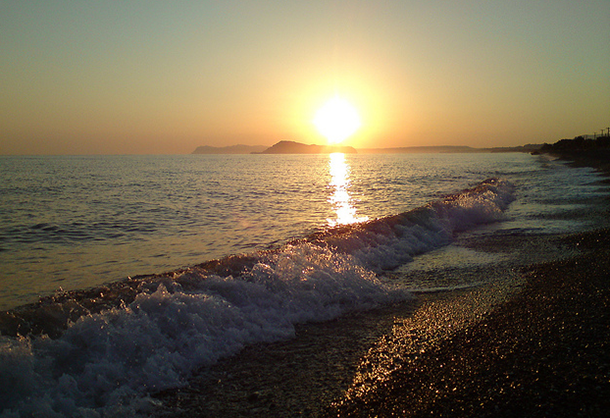
According to Maratou, a cursed Greek baby girl arrived in a box at the edge of the Earth where the sun rose and set. The girl grew up with the sun ogre’s family and he became very attached to her. After many years pass, the sun ogre weds the now young woman, escaping her cursed fate. This is the union of the sun and the moon. (Photo: Alexey Ivanov; Flickr CC BY-SA 2.0)
CURWOOD: It’s the Living on Earth Holiday Storytelling Special: Season of Light. I’m Steve Curwood. On the sunny hillsides of Greece, light is a part of daily life of course. Farmers working the fields from sun up to sundown have come to know the sun, not just as a source of life and light, but as an ogre, breathing heat down upon them. But the sun ogre of Greece has a soft side and now we’re going to hear his story. Manya Maratou is a storyteller and musician from Greece. She lives in the village of Grammatiko, outside of Athens. Manya, Welcome to Living on Earth.
MARATOU: I’m very glad to be here.
CURWOOD: Now I understand, Manya that you’ve brought along a few instruments today. Can you tell me about them?
MARATOU: Yes, I have the ney which is a flute made of a reed, and it’s a traditional instrument. And I also have my drum, which is another traditional instrument.
[DRUMMING]
CURWOOD: I’m already thinking about ouzo and olive oil.
MARATOU: Already, yes.
CURWOOD: (laughs) And how about your flute?
[FLUTE MUSIC]
CURWOOD: Now, you’ve been a musician for some time. How did you become a storyteller?
MARATOU: I became a storyteller the moment I heard that story telling exists (laughs) as a profession. And the first time I saw a performance I was hooked.
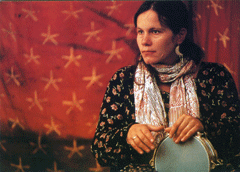
CURWOOD: (laughs) And you haven’t been able to stop ever since, huh?
MARATOU: I haven’t no.
CURWOOD: Now today you’re going to share a traditional Greek story with us. Um can you tell me how old you think this is and where you first heard it?
MARATOU: I’m going to tell you a story about the sun, where the sun is an ogre, a being. And I think that this story might be very, very, very old because it has a mythological feeling to it. And I first read it in a book; a collection of Greek stories. And it’s a Greek traditional story.
[FLUTE]
In the beginning the sky was lying on the earth. But the oxen and the cows they licked the sky and the sky didn’t like this at all. So one day he talked to the sea and he said, “Sea if I give you depth, will you give me height?” and the sea agreed. And from that day on the sky jumped high, high, high, as far away as he could from the earth. And as high as the sky is, that’s how deep the sea is. And between the sky and the sea, once upon a time, there was an island. And on that island there lived a couple; a man and his wife. They were married for about a year and the wife had just given birth to their first baby. She was three days old and on that night, it was the very darkest hour, the mother was lying on the bed, looking, watching her little baby in the cradle. The father was away. He was working.
And at that moment the door to the room opened. And in came an old woman dressed in black with a black headdress and a long nose. And she went and she stood over the baby’s cradle. And then a second old woman came in. She was dressed in black and she had a black headdress on and through the folds of the headdress out poked her long long nose. And she went and she stood right next to her sister, the first one who came in. And behind them there came a third old woman. She was dressed in black. She wore a black headdress. And she had a long, hooked, pointed, hairy nose. And she stood right next to her sisters.
And then the first old woman spoke. And she said, “It is the fate of this little girl to be wise, to be good and kind and beautiful. And then the third old lady spoke out of turn and she said, “Wise and beautiful? Ok all that. Yes wise and beautiful and good and kind, but when she is eight years old she will die.”
The mother fainted when she heard these words. And so she didn’t hear what the second old woman had to say. And the second old woman said, “I cannot change what my sister said but I can say this, this girl will manage to live and grow up and not die only if she can be born for the second time.” And with those words, the three women they turned around and left the room one behind the other. And a while later the father came back from work. He found his wife fainted on the bed and as he stroked her to wake her up, as she woke up, she started crying and sobbing. And the father asked what had happened. And she said, she told him she was watching the little baby in the cradle and the door opened and three old women came in and she couldn’t tell him what the second one said because she hadn’t heard it.
And then the father he said, “If we keep this child and it grows up with us, for eight years we will love it too much. We will be very very sorry when she dies. So why don’t we put her out of the house now?” But the woman she couldn’t say anything. She just lay there on the bed. So the father, he took a box and he put the baby in the box. And then he closed the lid. And then he took the box and he took it down to the sea and he put it on the waves and the waves took the box with the baby inside and took it out. And the waves rocked the baby and it slept.
And a long time passed or a short time passed and one morning the box reached the very end of the world. And there, at the very end of the world, there is an island. And at the end of the beach there is a bridge. And that is the bridge where the sun goes up into the sky every morning to light up the world. And this morning the sun, as he was going up his bridge he saw the box and he called his mother and he said, “Mother there is a box on the beach. Take it into the house and open it. And if you see jewels inside keep them. Keep them for yourself and for my sisters. But if there is a human being inside, keep it for my dinner.”
And with those words he went up his bridge into the sky, lighting up the world. The sun’s mother went down to the beach and she took the box into the house. When she opened the box she saw the baby and the baby saw her. And the baby smiled and then the old woman smiled. And she pointed her finger and tickled her tummy and started playing with it. And the baby laughed. But as she was playing she remembered what her son had said, that he would eat a human being. So she put it back in to its little box, which was like a cradle and she started cooking.
And she got a great big ox and roasted it in the oven. And made 40 great big loaves of bread so her son would find plenty to eat and not be hungry when he came back. And when she had finished all her cooking and everything was ready then she took the little baby out and started playing with it again. And she didn’t want the sun to eat it up so she patted it on its back and it turned into a pot with a rose bush in it. And she put the pot with the rosebush onto the windowsill.
And at that moment the sun banged open the door of the kitchen and he came into the kitchen and he said, “MMMMMM Somewhere here I smell a human being.” And the old woman she said, “Oh, my son you walk over the human beings all day long. Their smell has gotten up into your nostrils. That’s why you smell, there’s no human being here. Here, have your dinner.” And she brought in the bread, and she brought in the ox. And he ate and he ate until he was full and satisfied.
And then he threw his knife, and his fork, and his napkin onto the table and he laid back into his chair and he put his arms on his belly and he said, “Ahh, yes. That was a good meal.” And his mother said, “Son, are you hungry? Do you want something else?” “No, mother I’m not hungry.” “Are you sure you’re not hungry anymore? Are you sure you don’t want me to cook something else for you?” And the sun he said, “Oh, mother stop talking about food. I’m full up. But tell me, what was in that box on the beach in the morning?” And the mother, she took down the pot from the windowsill and she patted it and it turned back into the baby. And she took the little baby girl and put her into the sun’s arms. And the sun looked at the baby. And the baby looked at the sun. And he was so beautiful. He was handsome and shining and golden that the baby smiled. And then the sun, he smiled too. And he put out his finger and he tickled the baby’s tummy and the baby laughed. And he started playing with the baby. And he liked it. He liked playing. And he turned to his mother and he said, “Mother, we’re going to keep this little baby in our home and she’s going to grow up with us.”
And so the little girl, she grew up in the sun’s home. And the sun enjoyed having her at home so much that some times it took him a long time to leave the house in the morning because he was playing with the baby. And sometimes he rushed back much too early to go and tell stories to the little baby at bedtime. And the years past and she became a little child. And then more years passed and she became a young woman. And one day the sun said to his mother, “Mother, I want to marry this young woman.”
But at that moment one of the sun’s sisters she spoke and she said, “Oh, you can not marry that girl.” And the sun’s mother said, “And tell me why can’t he marry this girl?” And the sun’s sister said, “Well, it’s written in the fate of the sun that he cannot marry a girl who hasn’t been born twice.” And the sun’s mother said, “And how do you know that?” And the sun’s sister said, “Oh, how do I know that? I am one of the sun’s rays. I shine on the earth and I can see everything that is happening on the surface of the earth but also hidden things. And I know everything.” And then his mother said, “Uh huh, you know everything, so how don’t you know this girl has been born twice? The first time she was born from her mother. The second time she was born from the sea.”
And so that is how this little girl was freed of her fate. And she lived on in the house of the sun and she became his wife. And from that day on, the sun, every time he went out, he took all his rays with him because they were jealous. And the girl she stayed in the house with his mother. But because she was a little bored staying all day long in the house he let her go out at night sometimes by herself. And he made a lovely dress for her to wear at night when she went out. And on that dress the sun he sewed many little lights so they could shine at night and show her the way back so she wouldn’t get lost. And they lived happily ever after. And that is the story of how the sun got married to the moon.
CURWOOD: Ah, so that’s what happened?
MARATOU: That’s how it happened.
CURWOOD: (laughing)
MARATOU: That’s what they say in Greece.
CURWOOD: But let me tell you this: if the sun’s out all day and the moon is out all night when do they ever, well, get together?
MARATOU: Well, the moon is not out all night long. She goes out sometimes, and sometimes she goes out for a very little while. And then goes running back home.
CURWOOD: (laughs) You know in some cultures the sun is a warm god, a friendly god, or a very powerful god. But in Greece he’s an ogre? How come?
MARATOU: In Greece the sun shines and he’s very very very strong. He can be sweet in the spring but when the summer comes and the days get to be very very very long the sun is very very hot. And we even have a saying in the summer, mothers tell their children, “Don’t go out without a hat on because the sun might hit you.”
CURWOOD: (laughs) Now, I’m thinking that when the girl in the story is a baby she just charms the sun ogre just by being a baby. And he ends up staying late at home in the morning, not getting to work as early as he used to, and then cutting out rather early to be with her and read her stories, which of course, means our winter. But I’m just wondering if you relate with that sun ogre, Manya. I mean how often do you tell stories to your own children?
MARATOU: At least every day. And you’re probably right. This uh bringing children up from baby hood it is a growing thing. You’re charmed in the beginning and then as time passes this love gets deeper and deeper and it’s the common experience I think. Just as the sun in the story, yes?
CURWOOD: And so the myth tells us that we’re suffering in wintertime the loss of light because of the care of a child?
MARATOU: Maybe and maybe when she grows up that is the time when the sun and the moon are together.
CURWOOD: (laughs) Manya Maratou is a storyteller who lives in Greece. Thank you so much.
MARATOU: Thank you very much.
Related link:
Manya Maratou’s page
[MUSIC Winter Soltice Piano Songs Academy “I was alone”]
CURWOOD: Living on Earth is produced by the World Media Foundation. Naomi Arenberg, Bobby Bascomb, Emmett Fitzgerald, Lauren Hinkel, Helen Palmer, Adelaide Chen, and Jenni Doering all help to make our show.
Our story-tellers were produced by Ashley Ahearn, with engineering by Dennis Foley, James Curwood, and Karlyn Daigle.
Alison Lirish Dean composed our themes.
You can find us anytime at L-O-E dot org - and like us, please,at our Facebook page - it’s PRI’s Living on Earth.
And we tweet from @livingonearth.
I'm Steve Curwood.
Thanks for listening!
[MUSIC: Manya Maratou “Seasonal Greek Flute, Drum & Singing Music” performed live in the ‘ERT Studios (Athens, Greece)’ studio (December - 2006)]
ANNOUNCER1: Funding for Living On Earth comes from the Grantham Foundation for the protection of the environment, supporting strategic communication and collaboration in solving the world’s most pressing environmental problems. The Kendeda Fund, furthering the values that contribute to a healthy planet, and Gilman Ordway for coverage of conservation and environmental change. Living on Earth is also supported by Stonyfield Farm, makers of organic yogurt, smoothies and more; www.stonyfield.com.
ANNOUNCER2: PRI. Public Radio International.
Living on Earth wants to hear from you!
Living on Earth
62 Calef Highway, Suite 212
Lee, NH 03861
Telephone: 617-287-4121
E-mail: comments@loe.org
Newsletter [Click here]
Donate to Living on Earth!
Living on Earth is an independent media program and relies entirely on contributions from listeners and institutions supporting public service. Please donate now to preserve an independent environmental voice.
NewsletterLiving on Earth offers a weekly delivery of the show's rundown to your mailbox. Sign up for our newsletter today!
 Sailors For The Sea: Be the change you want to sea.
Sailors For The Sea: Be the change you want to sea.
 The Grantham Foundation for the Protection of the Environment: Committed to protecting and improving the health of the global environment.
The Grantham Foundation for the Protection of the Environment: Committed to protecting and improving the health of the global environment.
 Contribute to Living on Earth and receive, as our gift to you, an archival print of one of Mark Seth Lender's extraordinary wildlife photographs. Follow the link to see Mark's current collection of photographs.
Contribute to Living on Earth and receive, as our gift to you, an archival print of one of Mark Seth Lender's extraordinary wildlife photographs. Follow the link to see Mark's current collection of photographs.
 Buy a signed copy of Mark Seth Lender's book Smeagull the Seagull & support Living on Earth
Buy a signed copy of Mark Seth Lender's book Smeagull the Seagull & support Living on Earth

